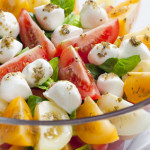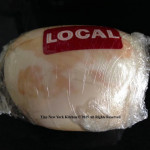Use The Leaves
The leafy green stems of beets or radishes make a tasty side dish when sautéed with garlic and olive oil. Try blending carrot greens with olive oil, Parmesan cheese, and a squeeze of lemon for a tasty pesto.
Slice The Stems
Broccoli stalks are the perfect size for spiralizing and make a crunchy addition to salads.
Zest The Rind
Citrus peels are packed with sweetness. Their flavorful zest will elevate any marinade, vinaigrette, or dessert.
Vegetable Stock
And, of course, you can make homemade vegetable stock.
“Work With What You Got!”
©Tiny New York Kitchen © 2018 All Rights Reserved
Paleo Diet
The Paleo Diet (short for Paleolithic) is fashioned around the eating habits and available foods of our hunter-gatherer ancestors. These ancestors had to nourish themselves with the meat, fish, fruits, vegetables, nuts, and fats available to them in nature. With the benefit of large supermarkets, it’s easy today to mimic these foods in wider variety. Specific recommendations for eating Paleo will vary; however, the main ideas are the same: Reduce the risk of debilitating diseases and optimize health by eating whole, fresh, unprocessed foods and avoid foods that were not available prior to the advent of modern agriculture.
Research studies looking at the Paleo Diet have noted that eating a Paleo Diet for a short term improved the glucose control and lipid profiles in people with type 2 diabetes, compared to eating a diet containing low-fat dairy, moderate salt intake, whole grains, and legumes. Additional research indicates similar results may be possible in people without type 2 diabetes as well. The Paleo diet may result in higher levels of satiety (fullness) throughout the day when compared with a low-fat, low-calorie diet.
Paleo Do’s
Eat plenty of non-starchy vegetables and fruits.
Make fresh meat, poultry, fish, and seafood your primary sources calories.
Avoid highly processed meats that contain preservatives, artificial flavors, and sugar, such as some sausages, bacon, deli meats, and smoked fish products.
Consume nuts and seeds.
Use coconut oil, grass-fed butter, olive oil, avocado oil, nut and seed oils, and animal fats, such as goose fat or duck fat, for cooking and eating.
Balance the intake of acid-producing foods (meats, fish, salt, and cheese) with base-producing foods (fruits and vegetables) for optimal health.
Use sea salt to season foods, but try to decrease sodium intake in general.
Paleo Don’ts
Consume highly processed packaged foods.
Get heavy handed with the salt shaker.
Eat grains of any kinds. Quinoa, bulgur, rice, wheat, bread, pasta, etc., are all out.
Consume sugar (including honey and maple syrup), sweets, candy, or desserts.
Use artificial sweeteners, such as monk fruit extract, stevia, NutraSweet or Equal (aspartame), Splenda (sucralose), or sugar alcohols, such as xylitol, sorbitol, or maltitol.
Eat legumes, beans, peas, lentils, or soy, or foods make from soybeans.
Use canola or soybean oils or consume hydrogenated oils (trans fats).
Consume dairy, with the exception of fermented dairy or raw milk cheese on occasion.
“Work With What You Got!”
© Victoria Hart Glavin Tiny New York Kitchen © 2016 All Rights Reserved
Japanese Pantry
Add these Japanese items to your pantry and you’ll reach for them again and again. Some of these items are common enough that you can find them at Whole Foods or your local health food store. Others might require a trip to an Asian grocery store or an online order. Your efforts will be richly rewarded.
Sake
You don’t need to spend a lot of money on fancy sake for cooking, but a decent bottle is tastier and more complex than cooking sake.
Kombu
This mineral rich dried kelp is what gives dishes depth. The sheets should be sturdy with fine sea salt on the outside. Look for labels that say “kombu.”
Bonito Flakes
Dried, fermented, and smoked skipjack tuna (also known as katsuobushi) that is the yin to kombu’s yang in dishes. Quality ranges widely. You do get what you pay for here.
Rice Vinegar
Avoid seasoned rice vinegar, which has sweeteners and other additives in it. Choose a brand that lists rice and water as the only ingredients.
Miso
It encompasses a range of fermented soybean pastes, from younger fresh-tasting white to long-aged, funky red. The latter, which is mellow and sweet, is the best intro.
Mirin
Brewed from sticky rice, this cooking wine is sweeter and less alcoholic than sake. Pick one made with sugar rather than glucose or corn syrup because you can taste the difference.
Togarashi & Sansho
Make fruity togarashi chile powder your new Aleppo. Sansho, made from the husks of sansho peppercorns, lends tongue-tingling anise notes.
Short-Grain White Rice
With its pearly grains and subtle flavors, koshihikari is the crème de la crème of Japanese short-grain rice.
Usukuchi Soy
Lighter, thinner, and saltier than standard soy, usukuchi is perfect for seasoning dishes like yosenabe (hot pot) without darkening the color too much.
“Work With What You Got!”
© Victoria Hart Glavin Tiny New York Kitchen © 2016 All Rights Reserved
This makes me very angry. I just bought this mozzarella from Whole Foods a few days ago and it’s already turning bad.










